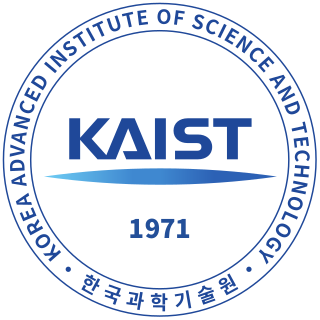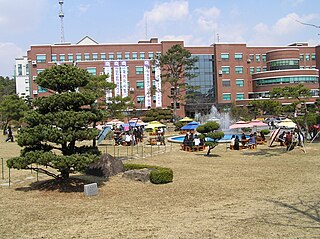
The Korea Advanced Institute of Science and Technology (KAIST) is a national research university located in Daedeok Innopolis, Daejeon, South Korea. KAIST was established by the Korean government in 1971 as the nation's first public, research-oriented science and engineering institution. KAIST is considered to be one of the most prestigious universities in the nation. KAIST has been internationally accredited in business education, and hosts the Secretariat of the Association of Asia-Pacific Business Schools (AAPBS). KAIST has 10,504 full-time students and 1,342 faculty researchers and had a total budget of US$765 million in 2013, of which US$459 million was from research contracts.

The economy of South Korea is a highly developed mixed economy. By nominal GDP, the economy was worth ₩2.61 quadrillion. It has the 4th largest economy in Asia and the 12th largest in the world as of 2024. South Korea is notable for its rapid economic development from an underdeveloped nation to a developed, high-income country in a few decades. This economic growth has been described as the Miracle on the Han River, which has allowed it to join the OECD and the G20. It is included in the group of Next Eleven countries as having the potential to play a dominant role in the global economy by the middle of the 21st century. Among OECD members, South Korea has a highly efficient and strong social security system; social expenditure stood at roughly 15.5% of GDP. South Korea spends around 4.93% of GDP on advance research and development across various sectors of the economy.
Technology transfer (TT), also called transfer of technology (TOT), is the process of transferring (disseminating) technology from the person or organization that owns or holds it to another person or organization, in an attempt to transform inventions and scientific outcomes into new products and services that benefit society. Technology transfer is closely related to knowledge transfer.

Korea Train eXpress (Korean: 한국고속철도), often known as KTX, is South Korea's high-speed rail system, operated by Korail. Construction began on the high-speed line from Seoul to Busan in 1992. KTX services were launched on April 1, 2004.

Pohang University of Science and Technology (POSTECH) is a private research university in Pohang, South Korea.

Konyang University, located in Nonsan, South Korea, was founded in 1991.

Vinylon, also known as Vinalon, is a synthetic fiber produced from reaction between polyvinyl alcohol (PVA) fiber and formaldehyde. Chemically it is polyvinyl formal (PVF). Vinylon was first developed in Japan in 1939 by Ri Sung-gi, Ichiro Sakurada, and H. Kawakami. In North Korea, Ri Sung-gi found a route to produce PVA from domestic anthracite and limestone as raw materials. Trial production began in 1954 and in 1961 the massive "Vinylon City" was built in Hamhung, North Korea. Vinylon's widespread usage in North Korea is often pointed to as an example of the implementation of the Juche philosophy, and it is known as the Juche fiber.

Kwangwoon University is a comprehensive and private research university in Nowon-gu, Seoul, South Korea, offering undergraduate and graduate programs. Chosun Radio Training Center, the predecessor of Kwangwoon University, was the first institution to teach electronic engineering studies in Korea. The foundation is Kwangwoon Academy, an incorporated educational institution. As of 2019, there are 11,500 undergraduates and 1,292 graduate students.

EveR is a series of female androids developed by a team of South Korean scientists from the Korea Institute of Industrial Technology in Korea University of Science and Technology. The project is headed by Baek Moon-hong and was unveiled to the public at the Kyoyuk MunHwa HoeKwan hotel in Seoul on May 4, 2003. The EveR name is derived from the combination of the Biblical "Eve" and the r from robot.

HSR-350x, alternatively called G7, KHST or NG-KTX, is a South Korean experimental high-speed train. It was developed and built in a joint project of government research institutes, universities and private companies that started in 1996, which aimed to reduce import dependence in high-speed rail technology. New components developed for the HSR-350x included motors, electronics, and the carbody of passenger cars. Test runs were conducted between 2002 and 2008. The experimental train achieved the South Korean rail speed record of 352.4 km/h (219.0 mph) in 2004. The HSR-350x was the basis for Korail's KTX-II (KTX-Sancheon) commercial high-speed trains.

The Gyeongbu high-speed railway, also known as Gyeongbu HSR, is South Korea's first high-speed rail line from Seoul to Busan. KTX high-speed trains operate three sections of the line: on 1 April 2004, the first between a junction near Geumcheon-gu Office station, Seoul and a junction at Daejeonjochajang station north of Daejeon, and a second between a junction at Okcheon station, southeast of Daejeon, and a junction near Jicheon station, north of Daegu entered service; then on 1 November 2010, the third section, between a junction west of Daegu and Busan became operational. The missing gaps across the urban areas of Daejeon and Daegu were in construction for an expected opening in 2014, separate tracks into Seoul Station were also planned. The temporary ends of the three sections were connected to the parallel conventional Gyeongbu Line by tracks that will serve as interconnector branches upon the completion of the entire line. On 1 August 2015, construction on urban areas of Daejeon and Daegu were completed; all the sections of HSR line were connected.

Huangpu, alternately romanized as Whampoa, is one of 11 urban districts of the prefecture-level city of Guangzhou, the capital of Guangdong Province, China. Despite its name, it does not include Huangpu Island or its famous anchorage. Huangpu absorbed Guangzhou's former Luogang District in 2014. The district has been awarded the status of "Happiest District of China" in 2020.

The KTX-Sancheon is a South Korean high-speed train built by Hyundai Rotem in the second half of the 2000s and operated by Korail since March 2010. With a top speed of 305 km/h (189.5 mph), the KTX-Sancheon is the second commercial high-speed train operated in South Korea and the first domestic high-speed train that is designed and developed in South Korea.

According to a report by The Economist, Iran has been ranked 39th for producing $23 billion of industrial products in 2008. From 2008 to 2009 Iran has leaped to 28th place from 69th place in annual industrial production growth rate.

Seoul National University of Science and Technology is a national university located in Nowon-gu, Seoul, South Korea.
The automotive industry in North Korea is a branch of the national economy, with much lower production than the automotive industry in South Korea. In North Korea motor vehicle production is focused on military and industrial goals, including construction; few private citizens own cars.

Science and technology in South Korea has advanced throughout the decades. The advancement of science and technology has become an integral part of economic planning in South Korea. Fast-growing industries have created a massive demand for new and more advanced technologies. Additionally, Korean engineers and scientists propose that the advancement of science and technology in partnership with North Korea could help facilitate the peaceful reunification of North and South Korea.
Innovation in Malaysia describes trends and developments in innovation in Malaysia.
Science and technology in Kazakhstan – government policies to develop science, technology and innovation in Kazakhstan.
The Ministry of SMEs and Startups is a ministry of the Republic of Korea, established in July 2017 by the Moon Jae-in government. It succeeds the former Small and Medium Business Administration. The headquarters are located in Sejong City, Sejong. As of February 2021, Lee Young, a member of the National Assembly and People Power Party, has been appointed as the South Korean Minister of SMEs and Startups.














